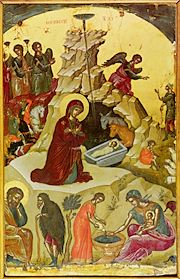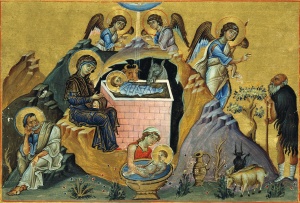The Nativity according to the flesh of our Lord, God and Saviour Jesus Christ, also called Christmas, is one of the Great Feasts of the Orthodox Church, celebrated on December 25.
In the fullness of time,[note 1] our Lord Jesus Christ was born to the Holy Theotokos and Virgin Mary, thus entering into the world as a man and revealing Himself to mankind.
According to the Bible and to Holy Tradition, Jesus was born in the city of Bethlehem in a cave, surrounded by farm animals and shepherds. The baby Jesus was born into a manger from the Virgin Mary, assisted by her husband St. Joseph. St. Joseph and the Theotokos were forced to travel due to a Roman census; the odd location of the birth was the result of the refusal of a nearby inn to accommodate the expecting couple (Luke 2:1-20). Since it is known historically that dwellings were built directly over such caves housing livestock--in order to make use of the heat
Though three magi from the East are commonly depicted as visiting during the event itself (or, in Roman Catholic tradition, twelve days thereafter), the Bible records the coming of an unspecified number of wise men as being a few years after Jesus' birth (see Matthew 2). In either case, these magi came bearing gifts of gold, frankincense, and myrrh (Matt 2:11). In the hymnography for the feast, these gifts are interpreted to signify Christ's royalty, divinity, and suffering.
Though Jesus' birth is celebrated on December 25, most scholars agree that it is unlikely he was actually born on this date. The choice of December 25 for the Church's celebration of the Nativity is most likely to have been in order to squelch attendance at pagan solstice festivals falling on the same day.
At least, this is the urban myth promligated by both heterodox Christians and unbelivers for centuries.
However, the solstice festival fell on the 21st of December. To suggest that The Church chose a day of sacred observance defensivly instead of pro-actively is to devalue and disregard the sacred and authoritative action of The Church in establishing a proper date for the observance of The Nativity of Christ The Lord.
Others within The Orthodox Church have observed that, under Hebrew law, male infant's were both circumcised and received their name eight days after their birth.
(See The Account of The Circumcision and Naming of John--The Forerunner and Baptist--in The Gospel according to The Apostle Saint Luke 1:59-66, and The Account of The Circumcision and Naming of Christ The Lord as Jesus in Luke 2:21 )
Also, within The Orthodox Church, January 1st is celebrated as the "name day" of The Lord Christ Jesus. Thus, the selection of December 25th to celebrate the nativity of The Christ (who would not be named for eight more days) would appear to have been a conscious counting backward from the first day of the calendar year--the day of his being proclaimed Son of Man--to the date of His birth, the day of his being proclaimed Son of God.
Celebration of the feast
Nativity fast
The cycle starts with a fast of forty days that precedes the feast. It is called the Nativity fast or Advent. For the faithful, it is a time to purify both soul and body to enter properly into and partake of the great spiritual reality of Christ's Coming, much like the preparation for the fast of the Lord's Resurrection.
The beginning of the fast on November 15 is not liturgically marked by any hymns, but five days later, on the eve of the Feast of the Presentation of the Theotokos, we hear the first announcement from the nine "Irmoi" of the Christmas Canon: "Christ is born, glorify Him!"
This period includes other special preparatory days announcing the approaching Nativity: St Andrew's Day, November 30; St Nicholas Day, December 6; the Sunday of the Forefathers; and the Sunday of the Fathers.
December 20th begins the Forefeast of the Nativity. The liturgical structure is similar to the Holy Week preceding Pascha. The Orthodox Church sees the birth of the Son of God as the beginning of the saving ministry which will lead Him, for the sake of man’s salvation, to the ultimate sacrifice of the Cross.
Eve of the Nativity
On the eve of the Nativity, the Royal Hours are read and the Divine Liturgy of St. Basil the Great is served with Vespers. At these services the Old Testament prophecies of Christ's birth are chanted.
There is also a tradition of Vale or Holy Supper. This is a 12 course lenten dinner served before the family goes to vespers.
Christmas vigil
The Vigil of Christmas begins with Great Compline because Vespers has already been served. At Compline there is the singing of the Troparion and Kontakion of the feast with special hymns glorifying the Saviour's birth. There are also the special long litanies of intercession and the solemn blessing of the five loaves of bread together with the wheat, wine, and oil. The faithful partake of the bread soaked in the wine and are also anointed with the oil. This part of the festal vigil, which is done on all great feasts, is called in Slavonic the litya and in Greek artoklasia, or the breaking of the bread.
The order of Matins is that of a great feast. Here, for the first time, the full Canon "Christ is born," is sung while the faithful venerate the Nativity icon.
Christmas Liturgy
Concluding the celebration of the Nativity of Christ is the Liturgy. It begins with psalms of glorification and praise instead of the three normal Antiphons. The troparion and kontakion mark the entrance with the Book of the Gospels. The baptismal line from Galatians 3:27 once again replaces the Thrice-Holy. The Epistle reading is from Galatians 4:4-7, the Gospel reading is the familiar Christmas story from Matthew (2:1-12), and then the liturgy continues in the normal fashion.
Twelve days of Christmas
The second day of the feast starts a two-day celebration of the Synaxis of the Theotokos. Combining the hymns of the Nativity with those celebrating the Mother of God, the Church points to Mary as the one through whom the Incarnation was made possible. St Stephen, the First Martyr, is also remembered on these two days.
On the Sunday after Christmas the Church commemorates James the Brother of Our Lord, David the King, and Joseph the Betrothed.
Eight days after the Nativity, is the feast of Circumcision of our Lord.
The festal period extends to Theophany during which time the Christmas songs are sung and fasting and kneeling in prayer are not called for by the Church. Throughout this time, it is the custom of some Orthodox Christians to greet each other with the words: "Christ is born!" and the response: "Glorify Him!" Many in the English-speaking world will also use the culturally common "Merry Christmas!"
Hymns
- Your Nativity, O Christ our God,
- Has shone to the world the Light of wisdom!
- For by it, those who worshipped the stars,
- Were taught by a Star to adore You,
- The Sun of Righteousness,
- And to know You, the Orient from on High.
- O Lord, glory to You!
Kontakion (Tone 3)
- Today the Virgin gives birth to the Transcendent One,
- And the earth offers a cave to the Unapproachable One!
- Angels with shepherds glorify Him!
- The wise men journey with a star!
- Since for our sake the Eternal God was born as a Little Child!
Christmas Carols
Greece and Cyprus
Greek tradition calls for children to go out with triangles from house to house on Christmas Eve, New Year's Eve and Epiphany Eve, and sing the corresponding folk carols, called the Κάλαντα (Kálanda, the word deriving from the Roman calends). There are separate carols for each of the three great feasts, referring respectively to the Nativity, to St. Basil and the New Year, and to the Baptism of Jesus in the River Jordan, along with wishes for the household.
Longer carols follow a more or less standard format: they begin by exalting the relevant religious feast, then proceed to offer praises for the lord and lady of the house, their children, the household and its personnel, and usually conclude with a polite request for a treat, and a promise to come back next year for more well-wishing.
Many carols are regional, being popular in specific regions but unknown in others, whereas some are popular throughout the two countries. Examples of the latter are the Peloponnesian Christmas carol "Christoúgenna, Prōtoúgenna" ("Christmas, Firstmas"), the Constantinopolitan Christmas carol "Kalēn hespéran, árchontes" ("Good evening, my lords"), and the New Year's carol "Archimēniá ki archichroniá" ("First of the month, first of the year"). The oldest known carol, commonly referred to as the "Byzantine Carol" (Byzantine Greek: Άναρχος θεός καταβέβηκεν, Ánarchos Theós katabébēken, "God who is beyond all authority descended"), is linguistically dated to the beginning of the High Middle Ages.
Almost all the various carols are in the common dekapentasyllabos (15-syllable iamb with a caesura after the 8th syllable) verse, which means that their wording and tunes are easily interchangeable. This has given rise to a great number of local variants, parts of which often overlap or resemble one another in verse, tune, or both.
In older times, carolling children asked for and were given gifts such as dried fruit, eggs, nuts or sweets; during the 20th century this was gradually replaced with money gifts — ranging from small change in the case of strangers to considerable amounts in the case of close relatives. Carolling is also done by marching bands, choirs, school students seeking to raise funds for trips or charity, members of folk societies, or merely by groups of well-wishers. Many internationally known carols, e.g. "Silent Night", "O Tannenbaum" or "Jingle Bells", are also sung in Greek translation.
Notes
- ↑ The entry in the Roman Martyrology states:
- "IN the year, from the creation of the world, when in the beginning God created heaven and earth, five, thousand, one hundred and ninety-nine (5199 BC); from the flood, two thousand, nine hundred and fiftyseven (2957 BC); from the birth of Abraham, two thousand and fifteen (2015 BC); from Moses and the coming of the Israelites out of Egypt, one thousand, five hundred and ten (1510 BC); from the anointing of King David, one thousand and thirty-two (1032 BC); in the sixty-fifth week, according to the prophecy of Daniel; in the one hundred and ninety-fourth Olympiad; in the year seven hundred and fifty-two from the founding of the city of Rome (752 BC); in the forty-second year of the empire of Octavian Augustus, when the whole earth was at peace, in the sixth age of the world, Jesus Christ, eternal God, and Son of the eternal Father, desirous to sanctify the world by His most merciful coming, having been conceived of the Holy Ghost, and nine months having elapsed since his conception, is born in Bethlehem of Juda, having become man of the Virgin Mary. THE NATIVITY OF OUR LORD JESUS CHRIST, ACCORDING TO THE FLESH."

